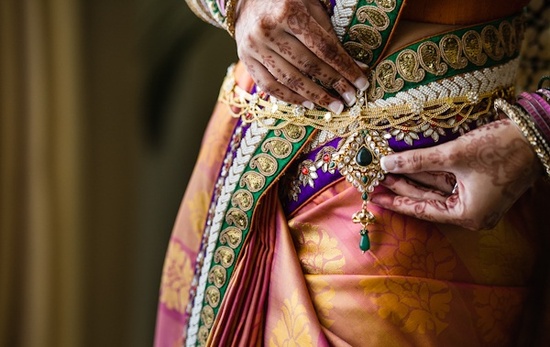Solah shringar refers
to the sixteen adornments of a Bride (Woman) for beautification. Solah Shringar
is especially important for an Indian bride on the most significant day of her
life. In India, the
beautification of the bride consists of sixteen parts and covers almost every
part of the body right from the head to the toe.
These solah shringar enhance
the beauty of the bride from head to toe, embellishing each part of part of
body stunningly. Thus, all the brides go
through this complete makeover for that special day. So, for all the girls
waiting to be brides, here is a quick look at the elating procedure of solah
shringar.
Mang Tika/ Jumar/ Matha patti
 |
| Mangtika |
 |
| Jumar - Side mang tika |
Side mang tika is also called as Jumar, It looks pretty but out of fashion of now! It ‘s a hair ornament which goes along the hairline, that can consist of one or several chains along with a tikka.
.jpg) |
| Some stylist one to match your wedding costume |
Hair Ornaments/flowers:
After styling the bride’s hair one can decorate the hairs with flowers & imitation jewellery designed for hair which also called as hair ornaments. |
| You can also try combination of jewellery flowers both |
 |
| Some trendy hair ornaments for reception ceremony |
Bindi :
 |
It has a strong religious implication and is a
sacred symbol of a married woman is put on the bride’s forehead and decorated
with red and white dots around it and along the eyebrows.
 |
| Some designer on specially for your wedding day |
Sindoor:

Sindoor is applied on the central
parting of the hair during the wedding ceremony. Sindoor is the mark of a
married woman in Hinduism
 |
| That's bigger though, but looks pretty |
The Bride is made to wear the Nose Ring making her look
traditional and ethnic. This ring is made of gold with pearls or other precious
gems and is worn on the left nostril and is supported by a gold chain, which
extends just behind left ear.
 |
| Maharashtrian style nose rings |
Earrings:
 Ear rings adorn the ears of the bride. Since the ear rings worn by bride are quite heavy they are normally supported by a gold chain passing over the crown of the head.
Ear rings adorn the ears of the bride. Since the ear rings worn by bride are quite heavy they are normally supported by a gold chain passing over the crown of the head.
It can be small loops or studs to large plates and dangling items. The size is ultimately depends on the physical capacity of the earlobe to hold the earring without tearing
Necklace:
 |
Armband/Bajuband
Baajuband or armlets are worn on the upper arms of the bride over the sari blouse.
Mehendi:
In India marriage is a very important celebrations, to make the wedding more colorful
applying mehendi art on hand is a custom. The wedding ceremony is incomplete
without mehendi function.


Bangles/Chudiya:
 |
| These beautiful one with name of your hubby |
 |
| you can keep it as option for mehendi gifts |
Rings:
 |
| Hathphulor |
 |
| Partywear rings |
Kamarband:
Kamarband is a beautifully designed gold or silver belt is worn around the waist of the bride studded mostly with beautiful gems. The belt not just enhances the waist area but also helps in holding the Sari or Dress in place.
Payal:


An anklet, also called ankle chain or ankle bracelet, is an ornament worn around the ankle. Barefoot anklets historically have been worn for centuries by girls and women in India, where it is commonly known as payal. Anklets are an important piece of jewellery in Indian weddings worn along with saris.

 A toe ring is a ring made out of various metals and non-metals worn on any of the toes. The second toe of either foot is where they are worn most commonly. This is because proportionately it's the longest toe and thus the easiest toe to put a ring on and stay without being connected to anything else.
A toe ring is a ring made out of various metals and non-metals worn on any of the toes. The second toe of either foot is where they are worn most commonly. This is because proportionately it's the longest toe and thus the easiest toe to put a ring on and stay without being connected to anything else.
Perfume/
Attar:
All our brides to be get ready to deck yourself up in the sixteen adornments of the Hindu ritual of Solah Shringar.


.jpg)










No comments:
Post a Comment